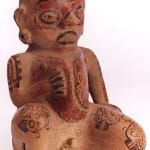Galo Polychrome Vessel Depicting A Kneeling Male, 500 CE - 1000 CE
Terracotta
8.25
PF.3577
This kneeling male figure comes from the Guanacaste-Nicoya polychrome tradition, the Galo polychrome style. Its mirror-bright burnished surfaces are technically unsurpassed by any Pre-Columbian pottery, and yellows, reds, oranges, creams,...
This kneeling male figure comes from the Guanacaste-Nicoya polychrome tradition, the Galo polychrome style. Its mirror-bright burnished surfaces are technically unsurpassed by any Pre-Columbian pottery, and yellows, reds, oranges, creams, maroons, and blacks of the polychrome decorations are impressively vivid. Among such sculptures are the full human figures with elaborate representations of tattoos or body paint. Such brilliant polychrome tradition represent an important social dimension; when the northern trade network that brought jade, slate-backed pyrite mirrors, foreign ceramics, and other luxury goods, the Nicoyans responded by producing their own special purpose pottery. Inspired by northern models, it also incorporated local and southern elements, forming a dazzling hybrid style that was traded around Central America and southern Meso-America in the centuries to come. Elaborately decorated with colors and patterns, this sculpted male is a dramatic depiction of power, prowess, and strength. A fine example of Galo polychrome figures, he provides a wealth of ethnographic detail because of the realistic style. His bold face, earspools, and body painting or tattooing are all vividly shown. He is kneeling on one knee with one hand on his thigh and the other hand on his chest. His chest is enhanced with patterns that appear to be armor-like plates protruding in the center. Perhaps the figure was a warrior wearing his armor or a high priest wearing his religious costume. His chest bulging out and his genital organ--a symbolic portrayal of male power--showing, this beautiful sculpture is the ultimate representation of prowess and strength. As we look at the sculpture, its honest, artistic beauty stuns us.



